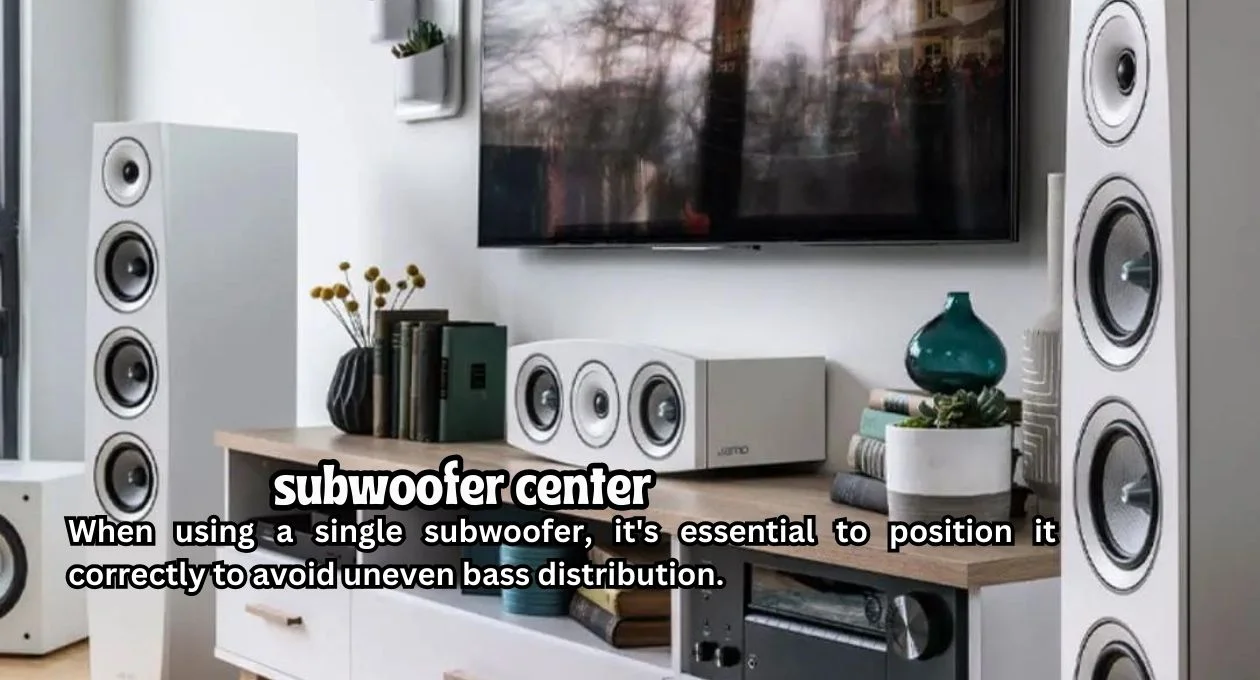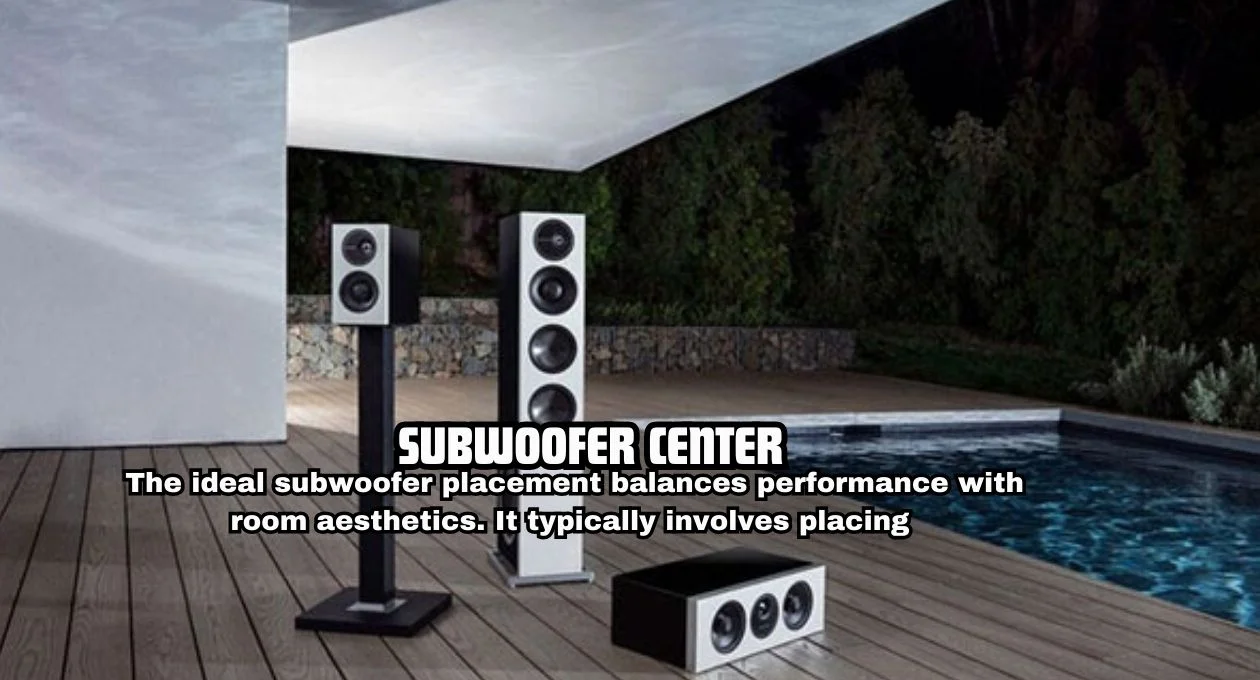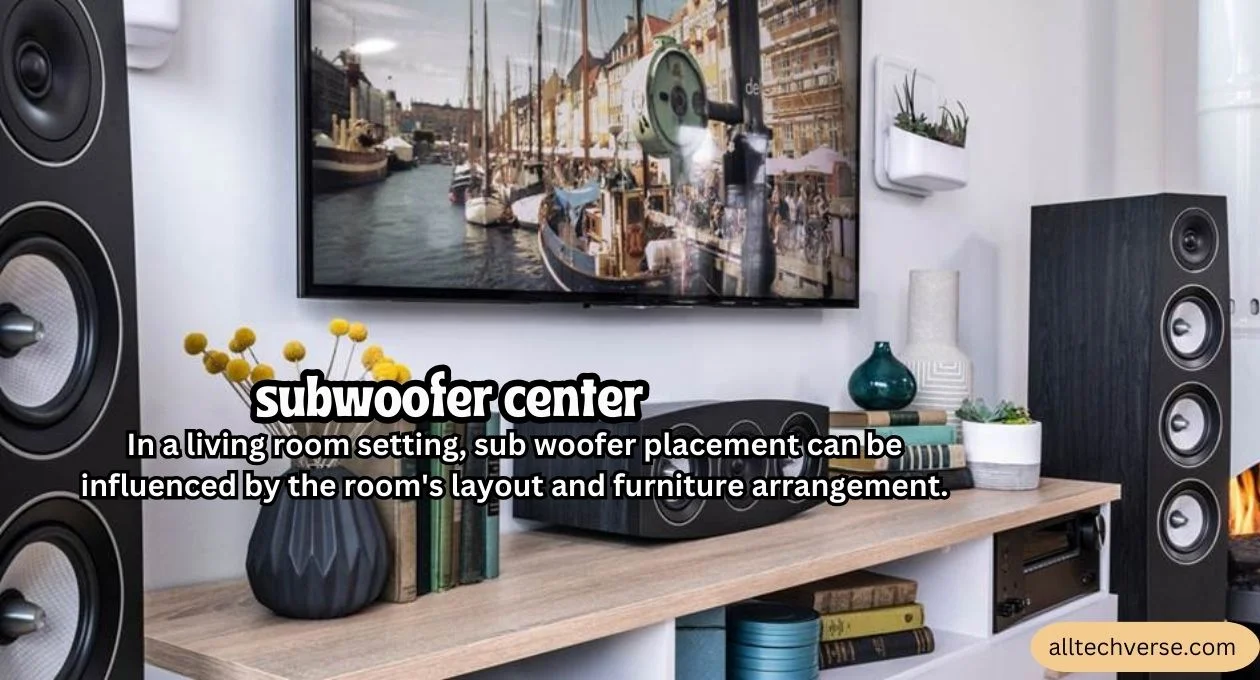When it comes to creating an immersive audio experience in your home theater or living space, the placement of your subwoofer center is crucial. The right positioning can enhance your sound system’s performance, delivering deeper bass and a more balanced audio experience. In this blog, we’ll explore various aspects of subwoofer placement, helping you determine the best location for your subwoofer to achieve optimal sound quality.
One of the key factors to consider when placing your subwoofer is the room’s acoustics. Hard surfaces, such as tile or hardwood floors, can reflect sound waves, while softer materials like carpets and curtains can absorb them. Ideally, you should aim to position your subwoofer in a way that takes advantage of the room’s layout, minimizing unwanted echoes and ensuring a cohesive sound throughout the space. Experimenting with different locations can help you identify the sweet spot where the bass response is most pronounced.
Another effective method for subwoofer placement is the “subwoofer crawl.” This involves temporarily placing your subwoofer at the listening position and playing a bass-heavy track. As you move around the room, listen for the location where the bass sounds most robust and balanced. Once you identify this spot, you can then position your subwoofer there for the best acoustic performance. By taking the time to evaluate your room’s unique characteristics, you can significantly enhance your audio experience.
Best Placement for Subwoofer
Finding the best placement for your subwoofer can make a significant difference in your audio setup. Proper placement ensures that you get the most out of your subwoofer, with rich, clear bass and minimal distortion. Factors such as room size, shape, and acoustics all play a role in determining the ideal location.
Additionally, consider using multiple subwoofers if your space allows. This approach can help to smooth out bass response and eliminate dead spots in the room, leading to a richer and more even sound. By strategically placing subwoofers in different locations, you can create a more immersive audio experience that fills the entire space without overpowering any specific area.
It’s also essential to factor in your furniture arrangement when planning your subwoofer placement. Large pieces of furniture can obstruct sound waves, diminishing the effectiveness of the bass. Make sure your subwoofer is positioned away from walls and large items to ensure optimal sound dispersion, allowing the deep frequencies to reach every corner of your room effectively.
Single Subwoofer Placement
When using a single subwoofer, it’s essential to position it correctly to avoid uneven bass distribution. One common method is to place the subwoofer in a corner, which can help reinforce the low frequencies. However, this might also lead to boomy or overly resonant bass. Testing different locations and using measurement tools can help you find the most balanced placement.
Another critical aspect to consider in sub woofer placement is the distance from your listening position. Ideally, the sub woofer should be positioned equidistant from the walls to promote uniform sound distribution. Too much distance from the listener can lead to a delay in sound waves, causing a disjointed audio experience. To counteract this, aim for a placement that balances proximity and room acoustics to achieve a seamless audio output.

Moreover, the orientation of your sub woofer can also influence sound quality. Experimenting with the angle at which your sub woofer faces can drastically change the character of the bass response. For instance, placing the sub woofer facing the listening area often creates a more direct sound, while side-firing models might offer a more diffused bass experience. Adjusting the orientation based on your room’s layout and your listening preferences can enhance your overall sound experience.
Best Location for a Subwoofer
The best location for a sub woofer often depends on the specific characteristics of your room. Generally, placing the sub woofer along the front wall or near a corner can enhance the low-frequency response. Avoid placing it too close to walls or in areas with heavy furniture, as these can interfere with the sound.
It’s important to consider the sub woofer’s integration with your main speakers when determining its placement. Ideally, the subwoofer should be positioned so that it aligns with the listening height, as this ensures a coherent sound stage. Often, aligning the sub woofer with the front speakers can reduce time delays and create a seamless transition between low and high frequencies. This alignment contributes to a more immersive listening experience, allowing for an effortless blend of sounds.
Another aspect to bear in mind is the use of room calibration systems. Many modern receivers come equipped with these automatic calibration features that can compensate for various placement challenges. By measuring the acoustics of your space, these systems can help optimize your subwoofer’s performance and adapt to its unique surroundings. Regularly revisiting the placement after adjustments can ensure that you maintain peak audio performance throughout your listening area.
Ideal Subwoofer Center
The ideal subwoofer placement balances performance with room aesthetics. It typically involves placing the subwoofer in a position where it can evenly distribute bass throughout the room. This often requires some experimentation, but common practices include using the “subwoofer crawl” technique to find the spot where the bass sounds the best.
In addition to placement, the room’s acoustic treatment plays a vital role in optimizing subwoofer performance. Utilizing acoustic panels and bass traps can significantly reduce unwanted resonance and improve sound clarity. By strategically positioning these treatments around your space, you can mitigate issues like excess echo and refinement of low frequencies, ensuring that your subwoofer delivers deep, impactful sound without muddiness.

Furthermore, experimenting with the crossover settings on your audio receiver can enhance the overall listening experience. Adjusting the crossover frequency determines how much of the bass is sent to the sub woofer versus the main speakers. Finding the right balance between these components will ensure a cohesive sound profile, allowing for seamless transitions between low and high frequencies while enriching the depth of audio playback throughout your room.
Subwoofer Placement in Room
Rooms with hard surfaces and large open areas may require different placement strategies compared to smaller, carpeted rooms. Consider using room acoustics treatments or bass traps to manage any unwanted resonance and improve overall sound quality.
When selecting a sub woofer, it’s essential to consider the specifications that align with your audio needs. Factors such as power output, frequency response, and enclosure type will influence the sub woofer’s performance and compatibility with your audio system. A well-chosen sub woofer can drastically enhance your listening experience, providing depth and richness that complements your overall audio setup.
In addition to technical specifications, aesthetic considerations should not be overlooked. A visually appealing sub woofer that blends with your room’s decor can enhance the overall ambience of your space. Look for designs that offer both functionality and style, ensuring that your sub woofer not only sounds great but also harmonises with your room’s interior design.
Subwoofer Placement Living Room
In a living room setting, sub woofer placement can be influenced by the room’s layout and furniture arrangement. Placing the sub woofer near the front of the room, close to your main speakers, can help integrate it into your overall audio setup. Avoid placing it behind large furniture or in a location where it might be obstructed.
When considering sub woofer placement in various room types, it’s important to account for the acoustic properties specific to each space. In a living room, where families often gather, positioning the sub woofer in an open area can allow for an even distribution of sound, ensuring that all listeners can enjoy rich, immersive bass without any hotspots or dead zones.

Moreover, the use of furniture can also affect sound dynamics. Strategically placing the sub woofer near softer furnishings, such as sofas or curtains, can help to absorb excess vibrations, reducing potential distortion and creating a more balanced audio environment. Experimenting with different placements within your living room can lead to optimal bass performance that complements your overall sound system setup.
Subwoofer Room Placement
Subwoofer room placement involves considering the room’s dimensions and acoustic properties to find the optimal spot for your subwoofer. This may require moving the subwoofer around and testing different locations to identify where it performs best. Keep in mind that every room is unique, so adjustments may be necessary.
Finding the right location for your sub woofer is not just about aesthetics; it’s essential for achieving the best possible sound performance. Experiment with different placements, such as near walls or corners, to discover where bass frequencies resonate most effectively. Additionally, consider the distance from other audio components, as this can impact the overall coherence of your soundstage. Regularly recalibrating your system after moving the sub woofer can help maintain optimal audio balance.
Don’t hesitate to use measurement tools and the listening position to verify the best setup. Tools such as mobile apps can provide insights into sound quality and frequency responses at various placements. Engaging friends or family in listening sessions can offer various perspectives on bass performance, ultimately guiding you to the ideal spot for your sub woofer. With patience and experimentation, you can unlock a rich and immersive auditory experience in your space.
Where Should I Place My Subwoofer
If you’re wondering where should I place my sub woofer, start by considering the basic principles of sub woofer placement. Test various spots in your room, focusing on areas where the bass sounds clear and even. Avoid corners and spots where the bass might become too boomy or muddy.
Another critical aspect to keep in mind is the integration of your sub woofer with the other components of your audio system. The ideal setup ensures seamless communication between the sub woofer and the speakers, allowing for a cohesive soundstage. Adjusting the crossover frequency on your sub woofer can help blend the bass with the mid-range and high frequencies emitted by your main speakers. This adjustment is vital for reducing frequency overlap, which can lead to muddiness in sound reproduction.

Finally, don’t underestimate the importance of calibration. Many modern sub woofers come with built-in room correction technologies that can assess your room’s acoustics and adjust settings automatically. Taking the time to use these features can drastically improve your listening experience. Additionally, fine-tuning the phase setting on your sub woofer can also aid in achieving a tighter and more defined bass response, enhancing the overall clarity of your audio setup.
Where Should I Put a Subwoofer
When deciding where should I put a subwoofer, consider both acoustic and practical aspects. Place the subwoofer in a location where it can provide balanced bass response without causing excessive resonances. Ensure it complements your main speakers and integrates well with your overall audio setup.
Finding the ideal position for your sub woofer can be a transformative experience for your audio enjoyment. Take into consideration the layout of the room, including any architectural features such as pillars, shelves, or different flooring materials, as these can all affect sound propagation. Additionally, measuring the distance from the sub woofer to the listening position is essential, allowing you to adjust settings accordingly for the best bass response.
Don’t forget to involve household members in your audio experiments; everyone’s listening preferences may vary. Performing listening tests as you move the sub woofer around the space can provide valuable insights into how different placements influence sound quality. Embrace the process as an opportunity to refine not just your sub woofer’s location, but also your overall audio setup for a richer listening experience.
Where Should I Put My Subwoofer
The question of where should I put my sub woofer often comes down to experimentation. Use methods such as the sub woofer crawl to find the best spot for even bass distribution. Additionally, adjust the sub woofer’s settings to fine-tune its performance based on its location.
Another factor to consider is the type of flooring in your room, as different materials can either enhance or dampen bass frequencies. For instance, hardwood floors may reflect sound waves better than carpeted surfaces, which tend to absorb lower frequencies. Testing various placements on both types of flooring can yield valuable insights into how the subwoofer interacts with these elements and ultimately contributes to the overall sound quality.
In addition to physical attributes, remember that the placement of audio equipment can also affect the performance of your sub woofer. Ensure that it is positioned away from any electronic interference, such as routers or microwaves, which may disrupt the signal. By paying attention to these finer details, you can create an ideal listening environment that allows the full capabilities of your audio system to shine.
Best Place for a Subwoofer
The best place for a sub woofer is typically a position where it enhances the bass response without introducing unwanted resonances or distortion. Commonly recommended spots include near the front wall or in the corner of the room, but individual room characteristics and furniture placement can affect the ideal location.
When considering the best placement for your subwoofer, it’s crucial to balance personal preference with acoustic principles. Many audiophiles find that positioning the subwoofer at a distance from other sound equipment not only improves clarity but also lends width to the soundstage. Pay attention to how the bass notes interact with the room’s dimensions, as this can significantly affect your overall listening experience. A little trial and error can lead to the discovery of the sweet spot where sound feels full and vibrant.
Additionally, consider the aesthetic aspects of subwoofer placement. While functionality is paramount, placing the sub woofer in a visually pleasing position can enhance the overall vibe of your audio setup. Integrating it with surrounding furniture or decor can create a seamless look, making it a natural part of your living space. Balancing sound performance with visual appeal will contribute to both a captivating auditory experience and a stylish home environment.
FAQs
1. How do I know if my subwoofer is placed correctly?
To determine if your subwoofer is positioned well, listen for clear and balanced bass without any muddiness or excessive boominess. Move around the room and note how the bass responds from different locations. If you experience uneven bass, consider experimenting with its placement further.
2. Can I place my subwoofer outside the main listening area?
Yes, while it’s common to place a sub woofer near the main speakers, it can also be effective to place it farther away. However, ensure that the subwoofer’s sound integrates well with the main speakers to avoid a disjointed audio experience.
3. What is the subwoofer crawl method?
The sub woofer crawl is a technique used to find the best spot for your subwoofer. Place it at your main listening position, then play a familiar track with strong bass. Crawl around the room, listening for the location where the bass sounds the best. That spot will be ideal for placing your subwoofer.
4. How can I adjust my subwoofer settings for optimal performance?
Fine-tuning the crossover frequency and phase settings is essential. Set the crossover frequency to blend well with your main speakers and adjust the phase to ensure that sound waves from the subwoofer align with those from the speakers for a tighter bass response.
5. Is it normal for my subwoofer to vibrate?
Some vibration is expected as subwoofers produce low-frequency sound waves. However, excessive vibration can indicate poor placement or settings. If vibrations are problematic, try repositioning the subwoofer or using isolation pads to minimize the transfer of vibrations to surrounding surfaces.

Conclusion
The placement of your subwoofer plays a critical role in achieving optimal sound quality in your home audio setup. By considering factors such as room acoustics, furniture arrangement, and the specific characteristics of your subwoofer, you can find the perfect spot to enhance your listening experience. Whether you’re using a single subwoofer or multiple units, proper placement ensures that you enjoy deep, clear bass and a balanced audio environment. Experiment with different locations, and trust your ears to find the best spot for your subwoofer center.
When setting up your home audio system, don’t overlook the importance of calibration. Using an audio calibration tool or an application can help you to adjust speaker levels and equalization settings according to your room’s acoustics. This process not only optimizes the subwoofer’s performance but also integrates it seamlessly with the rest of your audio equipment. Investing time in proper calibration ensures a more immersive listening experience, allowing you to enjoy music and movies as they were intended.
For More Information Keep Visiting AllTechVerse.



